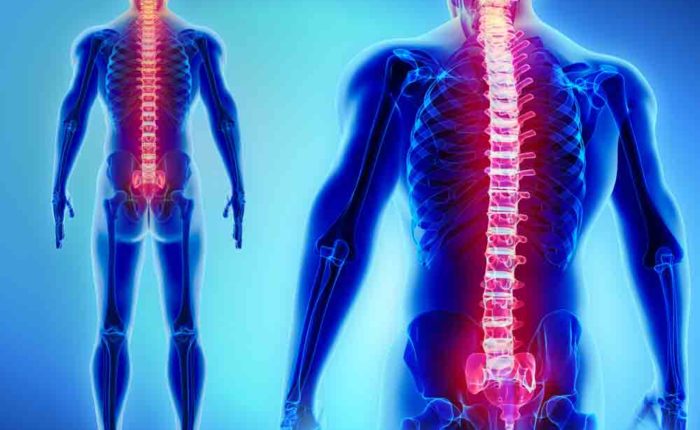The spinal cord is an essential part of your body’s communication system. It’s like a highway for messages that go from your brain to the rest of your body. You can think of your spinal cord as a main cable in a giant network. When someone has a spinal cord injury, it means this crucial communication line has been damaged and its ability to communicate has been disrupted.
A spinal cord injury (SCI) can be a life-altering event. An SCI can affect a person’s movement, sensation and ability to do daily activities. Globally, an estimated 15 million people are living with an SCI, including approximately 302,000 Americans. Each year in America, approximately 18,000 new SCI cases occur. A spinal cord injury can happen because of:
- Birth defect
- Violence
- Toxins
- Vehicle accident injury
- Degenerative or vascular condition
- Sports injury
- Infection
- Fall
- Tumor
An SCI means the person is facing learning a new normal. Their injury can result in the complete or partial loss of sensory and/or motor functions below their injury level. The good news is that with proper rehabilitation like physical therapy and a positive mindset, you can make amazing progress.
The impact of a spinal cord injury
Living with an SCI can present unique challenges. The extent of the SCI determines the specific effects, but common challenges include:
- Paralysis — Loss of movement in certain parts of the body
- Numbness — Loss of sensation in some regions of the body
- Chronic pain — Chronic pain can be a significant issue.
- Bowel and bladder dysfunction — Difficulty controlling these bodily functions
- Respiratory problems — Depending on the location of the injury
The role of rehabilitation for spinal cord injuries
Rehabilitation is crucial for individuals dealing with SCIs. It can be a truly tailored process aimed at maximizing their independence and quality of life. A multidisciplinary team will work together to create a comprehensive recovery plan personalized to the individual’s unique needs. This multidisciplinary team will likely include:
- Doctors
- Nurses
- Physical therapists
- Occupational therapists
- Speech therapists
The goals of rehabilitation for spinal cord injuries
The goals of rehabilitation can vary from person to person, depending on the severity of the injury. However, common objectives of SCI rehabilitation can include:
- Preventing complications — Addressing issues like pressure sores, infections, and contractures (shortening of the muscles or tendons)
- Improving mobility — Helping individuals regain as much movement as possible through therapeutic exercises and assistive devices
- Managing pain — Developing healthy coping strategies to deal with chronic pain
- Enhancing independence — Teach them skills for activities of daily living, like getting dressed, bathing and cooking
- Providing emotional support — Counseling and support are provided to help individuals cope with the challenges of an SCI and navigate their new normal.
- Returning to work or school — Assisting individuals in finding ways to participate as fully as possible in their education or employment
Physical therapy for spinal cord injuries
Physical therapy is the bedrock of spinal cord injury rehabilitation. Physical therapists use various techniques to help individuals regain strength, flexibility and balance. Physical therapy techniques used in SCI rehabilitation include:
- Range-of-motion exercises — These exercises involve moving the joints through their full range of motion to help maintain flexibility and prevent contractures. Range-of-motion exercises can help:
- Prevent stiffness
- Improve joint mobility
- Maintain muscle strength
- Strength training — Strength training focuses on building strength in muscles that may still be functional and help prevent atrophy in affected muscles. Strength training, which can include isometric exercises and functional electrical stimulation, can help:
- Enhance muscle strength
- Support joint stability
- Improve overall functional capacity
- Functional training — Functional training exercises are designed to help improve individuals’ ability to do everyday activities and tasks. It can include techniques like transfer training to teach individuals how to safely and effectively move from one position to another, as well as gait training for individuals with partial mobility to help them practice with assistive devices to improve walking ability. Functional training can help:
- Improve independence
- Improve daily function
- Improve overall quality of life
- Balance and coordination exercises — These are exercises aimed at improving balance, coordination and stability. Balance training may include activities such as standing on one foot or using a balance board. Coordination exercises will have the individual practice tasks that require precise movements, like reaching or manipulating objects. Balance and coordination exercises can help:
- Improve stability
- Reduce fall risk
- Improve overall functional coordination
- Wheelchair skills training — Wheelchair skills training focuses on helping individuals develop the necessary skills for effective and efficient use of a wheelchair. This can include wheelchair mobility training for maneuvering, turning and navigating various surfaces and wheelchair propulsion to teach efficient use of wheelchair propulsion techniques to conserve energy. Wheelchair skills training can help:
- Enhance mobility
- Boost independence
- Improve maneuverability in different environments
- Postural training — Postural training involves exercises and techniques intended to help improve posture and alignment. This can include learning proper alignment while sitting to help prevent pressure sores and promote comfort, as well as using cushions or supports to promote proper body alignment. Postural training can help:
-
- Reduce pressure sore risk
- Improve comfort
- Prevent musculoskeletal issues
- Endurance training — Endurance training involves exercises designed to help improve cardiovascular fitness and overall endurance. Endurance training can help:
- Improve cardiovascular health
- Boost energy levels
- Improve overall fitness
- Pain management techniques — Pain management techniques can help individuals alleviate and manage pain associated with their spinal cord injury. This may include techniques like heat therapy, cold therapy and manual therapy to help:
- Relax tense muscles
- Improve circulation
- Reduce inflammation
- Alleviate pain
- Aquatic therapy — Aquatic therapy involves physical therapy exercises done in a warm pool to take advantage of water’s buoyancy. It can also take advantage of the water jets or currents to help with movement or promote relaxation. Aquatic therapy provides a low-impact environment that reduces stress on joints and can boost mobility.
- Adaptive equipment training — Adaptive equipment training teaches individuals how to use a variety of assistive devices and home modifications to enhance daily function and independence.
This is just a glimpse of some of the techniques that can be tailored to each individual’s specific needs and goals during spinal cord injury rehabilitation. Working closely with their physical therapist can help ensure that the chosen techniques are appropriate and effective for each person.
Finding spinal cord injury rehabilitation near you
Finding a suitable spinal cord injury rehabilitation program near you is crucial for recovery and independence. Here are some avenues to help you find the right rehabilitation facility:
- Rehabilitation center directories
- Online search engines
- Hospital websites
- Your primary care physician or specialist
- Your discharge planner
- Recommendations
Once you have found a location you believe will work best for your recovery, make sure you:
- Consider accreditation
- Schedule tours if possible
- Meet with staff
- Evaluate services, such as:
- Specialized care tailored to SCIs
- Equipment and technology
- Support services
- Verify insurance benefits
By carefully considering these factors, you can find a spinal cord rehabilitation program that best meets your needs and supports your recovery journey.
SOL Physical Therapy: Your partner in spinal cord injury recovery
At SOL Physical Therapy, we understand the challenges faced by individuals with spinal cord injuries. Our specialized rehabilitation programs offer personalized care and comprehensive support to help you achieve your maximum potential. Our team of expert physical therapists is dedicated to helping you regain independence, improve mobility and enhance your overall quality of life. Let us be your partner in recovery.
Call us or request an appointment today to learn more about our spinal cord injury rehabilitation services.


